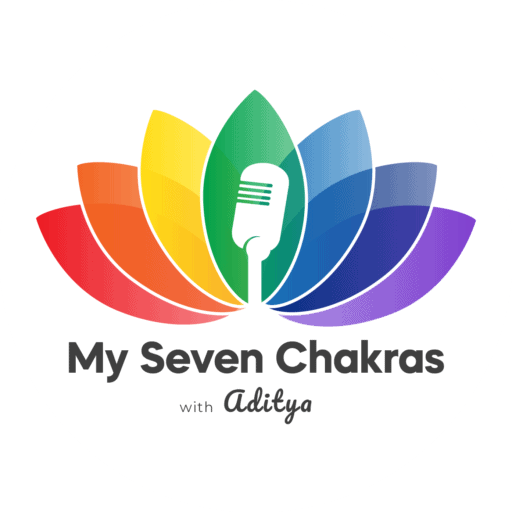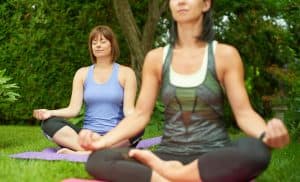13 Surprising Breathwork Benefits For Mental & Spiritual Wellbeing (2022)
Last Updated: September 29, 2022 | by Aditya Jaykumar
Do you ever feel like you’re constantly on the go, with your mind racing a mile a minute?
If so, you’re not alone. In our fast-paced world, it’s more important than ever to take some time for ourselves and focus on our mental and spiritual well-being.
Breathwork is a powerful way to harness the breath and use it to experience physical, mental, and spiritual balance, and in this article we’re going to explore some of the top breathwork benefits that are available to people in modern day life.
If you purchase through our partner links, we get paid for the referral at no additional cost to you! For more information, visit my disclosure page.
What is Breathwork?
Although really popular these days, Breathwork is an umbrella term for a range of ancient practices that have been used for centuries to improve health and well-being. There are many different breathwork techniques and methods, and each one can provide unique benefits!
Breathwork can also be a simple, personal practice that can be done anywhere, and the best part is that it doesn’t require any special equipment.

Regular practitioners will tell you that it is a great way to clear the mind and achieve a state of relaxed mindfulness.
In this article, we will share 21 breathwork benefits and dispel some common misconceptions about breathwork. We will also share the science behind these practices and explain why breathwork is so effective for modern-day life.
So let’s begin…
1) Lowers stress:
Deep abdominal breathing is one of the most effective ways to reduce stress and anxiety. When we breathe deeply, it activates the parasympathetic ‘rest and digest’ system, which lowers cortisol levels and helps us feel grounded and centered.
When we focus on our breath, it helps to quieten the ‘monkey mind’ – that constant stream of thoughts that can often make us feel anxious and stressed, especially if we’re in unfamiliar territory or among people that we haven’t met before.
Breathwork is a simple practice that anyone can do, and it only takes a few minutes to feel the benefits. The next time you’re feeling stressed, try deep abdominal breathing where you inhale through your nostrils for 4 counts and exhale slowly for 8 counts.
You may be surprised at how much better you feel after just a few breaths.
2) Increases energy:
Do you sometimes feel fatigued and drained? Controlled breathing can have a major impact on your energy levels.
When we breathe slowly and intentionally, we increase the amount of oxygen that reaches the mitochondria, optimizing ATP production.
This means that breathwork can be an excellent way to give yourself a natural energy boost, and the best part is that this works within minutes.

Plus, it’s a great alternative to coffee in the morning – you won’t have to worry about feeling jittery!
Box breathing is a recommended technique. To do it, simply breathe in for four counts, hold your breath for four counts, breathe out for four counts, and repeat. Give it a try next time you need an energy boost!
3) Improves creativity:
Feeling stuck and in a creative rut? Here’s why adjusting your breathing can help.
Most of us alternate between breathing through our left and right nostrils throughout the day without even realizing it. This is thanks to the nasal cycle, which alternates partial congestion and decongestion of the nasal cavities in humans and other animals.
The dominant nostril will alternate every few hours, and this can affect which side of the brain is more active. When your left nostril is dominant, the right side of your brain (creative/intuitive) is more active, and when your right nostril is dominant, the left side of your brain (logical/critical) is more active.
But what does this have to do with creativity?
Well, according to emerging studies, by controlling your breath and alternating between breathing through each nostril, you can improve your creative thinking. The logic is that if you can control which side of the brain is more active, you can better tap into your creative potential.
So if you’re feeling stuck without that creative spark, then try out the anulom vilom (alternate nostril) breathing technique!
4) Slows down aging:
Want to live forever? Not sure about forever, but breathwork certainly can help with longevity!
The key lies in the activation and mobilization of stem cells.
Stem cells are amazing cells that have the ability to turn into virtually any other type of cell in our body. This paves the way for being able to replace lost or damaged organs. Stem cells may hold the key to replacing cells lost in situations such as spinal cord injury and many progressive, devastating diseases such as Parkinson’s disease, multiple sclerosis, Alzheimer’s disease, diabetes, chronic heart failure, end-stage renal disease, liver failure and cancer.
While stem cells are anaerobic cells and their survival has been found to be better at low tissue oxygen levels, these cells are most susceptible to oxidative injury. The solution to this lies in temporarily reducing the level of oxygen and inducing brief, episodic hypoxia. This can be done through breathing techniques and breath control. By doing this, we can provide stem cells with the health benefits they need in order to survive and thrive.
Nisshesha rechaka, a type of Pranayama described in Hatha Pradeepika (H.P.) is the easiest way to produce brief, intermittent hypoxia.
What this means is that a steady and regular practice of yogic breathwork can indeed slow down aging due to a higher number of activated stem cells!
We highly recommend a book written by Dr. Prakash Malshe called Medical Understanding of Yoga in case you want to dive deeper and discover several facets of yoga that are unknown either to yogis or to medical doctors!
5) Boosts immunity and protects from pathogens:
Did you know that by breathing correctly, you can protect yourself from bacteria, viruses, and other pathogens? The key lies in breathing through your nose.
The nasal cavity is lined with a series of turbinates, or bony shelves, that play an important role in cleansing and humidifying the air that we inhale. The turbinates are covered with a thin layer of mucus, which traps dust and debris before they can enter the lungs. At the same time, the turbinates help to regulate the temperature and humidity of the air, making it suitable for the lungs.
The nasal cavity also produces nitric oxide (NO), which is a gas that plays an important role in self-healing. NO helps to kill invading bacteria, fungi, and viruses. The nasal cavity produces 900-1,100 parts per billion nitric oxide, which is used to kill invading bacteria, fungi, and viruses.
This is why mouth breathing must be avoided at all costs. Instead, deep breathing through the nose is essential for good health.
Slow, deep breathing exercises along with humming can help to increase NO levels by 15 to 20 times, which helps open up airways and kill pathogens.
Therefore, nasal breathing is essential for good health and well-being!
6) Improves digestion:
We all know that good digestion is key to feeling our best, but sometimes it can be difficult to achieve that goal.
Fortunately, there are ways to help improve our digestion, and one of the simplest is by practicing breathwork.
Breathwork helps you activate your parasympathetic nervous system, which is conducive to digestion. Your parasympathetic nervous system controls all the involuntary processes in the body, including digestion, and slow and deep breathing can relax muscles in the intestinal tract to promote absorption and digestion.
Furthermore, deep breathing supplies more oxygen to all body parts, including the digestive system, which aids in breaking down large particles of food into smaller units of sugars, fatty acids amino acids, and nucleotides.
Finally, slow diaphragmatic breathing will help massage your digestive organs so that they work effectively and reduce acid reflux, GERD, constipation, and IBS.
So next time you’re feeling a little bloated or uncomfortable after eating, try slow, diaphragmatic breathing for a few minutes. You’ll feel better in no time!
7) Aids in weight loss:
When it comes to weight loss, breathing may not be the first thing that comes to mind. But it turns out that breath plays a significant role in losing weight!
For one thing, breathwork improves your digestion and metabolism, which leads to healthy weight loss.
Secondly, according to researchers from the University of New South Wales in Australia, when weight is lost, the majority of it is breathed out as carbon dioxide. Their findings indicate that the lungs are the main excretory organ for weight loss!
The fat is converted to carbon dioxide and water. You exhale the carbon dioxide and the water mixes into your circulation until it’s lost as urine or sweat.
If you lose 10 pounds of fat, precisely 8.4 pounds come out through your lungs and the remaining 1.6 pounds turn into water. In other words, nearly all the weight we lose is exhaled.
This goes to show that breathing plays a vital role in weight loss.
So next time you’re looking to shed some pounds, remember to breathe consciously, deeply, and through your nose. And pay attention to your breathing pattern throughout the day.
8) Deepens Intuition and Spirituality:
Certain methods of breathwork help you enter altered states of consciousness.
Rebirthing breathwork, holotropic breathwork, and kundalini yoga are some examples of practices that can help you have a deep, meaningful experience of spirituality.
Some hypothesize that your body releases DMT during certain breathwork practices that help you access these non-ordinary states of consciousness.
DMT is a psychedelic tryptamine compound that occurs naturally in many plants and animals. It’s also referred to as the “spirit molecule” because it produces powerful hallucinations. This could explain why so many people report having profound spiritual experiences during breathwork practices.

The advantage of breathwork over plant medicine is that it is safe, and legal and doesn’t have a stigma attached to it. Be sure to work with an experienced instructor who can make you feel safe and hold sacred space for your spiritual breathing experience.
Additionally, Breathwork can help you to develop a stronger intuition.
When you’re in a state of deep relaxation, it’s easier for your subconscious mind to come to the surface. And when this happens, you can access information that you wouldn’t otherwise be able to tap into.
This is why many people use breathwork as a tool for divination and self-discovery.
Modern science is just beginning to discover the profound spiritual benefits of these ancient breathing practices, and our hunch is that these techniques will soon become more mainstream.
9) Helps increase or decrease body temperature at will!
Your autonomic nervous system acts largely unconsciously to regulate important bodily functions but did you know that breathwork can help you regulate your body temperature?
Whether you’re feeling too hot or too cold, certain Yogic and Buddhist breathing techniques can help you build inner heat or cool down within minutes.
Wim Hof is one breathwork master who has popularized the practice of cold exposure in the west through his workshops that feature ice plunges, tummo breathing sessions, and conscious connected breath.
Tummo breath, also called “vase breathing,” is a type of pranayama that’s said to build internal heat. This type of breathwork is often used in conjunction with meditation and yoga practices.
To do tummo breath, sit in a comfortable position with your spine. Sit in a comfortable position with your spine straight.
Close your eyes and take a few deep breaths in and out through your nose.
Once you’re feeling relaxed, begin exhaling through your mouth while making a “ha” sound. As you exhale, imagine that all the heat in your body is being released through your mouth.
Inhale slowly and deeply through your nose, imagining that you’re taking in the cool, refreshing air.
Repeat this pattern for a few minutes, or until you feel your body temperature begin to change.
10) Heals insomnia and improves sleep:
A good night’s sleep is essential for optimal health and well-being, but it can be elusive for many people. If you’re struggling to get enough shut-eye, breathwork may be able to help.
Breathing deeply and slowly has been shown to result in melatonin production, which not only promotes relaxation but also activates the parasympathetic nervous system.
Additionally, slow breathing alters your brainwaves and helps you produce alpha and theta brainwaves that help you prepare for deep, restful sleep.
The 4-7-8 breathing technique is one popular method that is recommended by many experts. To try it, simply inhale for four counts, hold your breath for seven counts, then exhale for eight counts. You can repeat this cycle as many times as needed until you feel yourself start to drift off to sleep.
11) Helps reduce chronic pain:
Do you know of anyone who experiences chronic pain?
Chronic pain is a type of pain that lasts for a long time – typically for more than 3 months. It can be caused by several health conditions, including arthritis, cancer, and diabetes.
Chronic pain can make everyday life a living nightmare, and interfere with your daily activities, such as working, having a social life, and taking care of yourself. If gone unchecked, chronic pain can also lead to conditions of depression and severe anxiety.
Breathwork is an effective way to alleviate chronic pain. This is because breathwork helps to release the tension that is often held in the body. Breathwork also helps to increase oxygenation of the blood, which can help reduce inflammation.
Finally, breathing techniques such as the Wim Hof breathwork can help increase our pain threshold. This is because deep breathing lowers the concentration of CO2 in the blood, creating a state of respiratory alkalosis, which helps transform our relationship to the sensory experience of pain.
12) Balances your chakras and cleanses your aura:
Breathwork is a powerful tool that can help to balance your chakras and purify your auric field.
We have seven major chakras, and each one is associated with a different aspect of our lives. When our chakras are balanced and our aura is clean, we feel healthy, vibrant, and connected. However, when they are out of balance, we can feel tired, anxious, and disconnected. One of the easiest ways to bring them back into balance is through breathwork.

The key to effective breathwork is breathing deeply and consciously. By breathing slowly and consciously, you allow more oxygen to reach your cells and organs, which helps to promote healing and balance.
Additionally, when you focus on your breath, you can begin to release any stuck or stagnant energy that may be causing an imbalance in your chakras.
Finally, using mantra during your breathwork practice can also help balance the chakras. Mantra is a repetition of sounds or words that create a vibrational frequency that helps to align and balance the energy in the body.
The next time you feel imbalanced, just take a deep breath and count to 4. After that, exhale for 12 counts and make the sound of ‘Aum’ that resonates throughout your body!
13) Improves balance and flexibility:
Qigong is a form of Chinese energy work that has been used for centuries to improve health and well-being. Qigong is a gentle, meditative exercise that blends movement, breathing, and intention, and this modality can be practiced by people of all ages and fitness levels.
One of the benefits of qigong is that it helps to improve balance and flexibility. This is because qigong helps to increase the flow of energy in the body. When the energy is flowing freely, we are less likely to experience stiffness or tightness in our muscles and joints.

Qigong is also a great way to improve flexibility because it helps to stretch the muscles, fascia, and connective tissues. When the muscles are stretched, they can move more freely and without pain.
Even today, in certain Chinese communities around the world, you might find some elders practicing this beautiful, graceful breathing practice early in the morning!
If you are looking for a gentle way to improve your balance and flexibility, qigong may be the perfect choice for you!
FAQS:
What does breathwork do to your body?
There are many different types of breathwork, and each one has its unique benefits. Some of the most common benefits include:
1) Increased oxygenation of the blood and improved cardiovascular health
2) Reduced stress and anxiety
3) Improved sleep quality
4) Reduced chronic pain
5) Alleviation of chronic conditions such as asthma and COPD
6) Improved balance and flexibility
7) Strengthened immune system
8) Better mental clarity and focus
9) Improved communication and connection with others
10) Greater inner peace and calmness.
How often should you do breathwork?
This depends on your goals and what you hope to achieve from breathwork. If you are using breathwork for general well-being, then once or twice a week is usually sufficient. However, if you are using breathwork to manage a specific condition or health concern, then it is best to practice breathwork daily.
Can anyone do breathwork?
Yes! Breathwork is suitable for people of all ages, fitness levels, and backgrounds. However, if you have any concerns or medical conditions that might be impacted by breathwork, it is always best to check with your healthcare practitioner first.
Wrapping Up
Breathwork is one of the oldest practices in the world and it’s still going strong today because of all the amazing benefits it has to offer.
The benefits of breathwork, as outlined above, are vast and continue to grow as research is conducted. From calming your mind to healing your emotions, deepening your spiritual connection and so much more, there’s something for everyone when it comes to breathwork.
If you haven’t tried breathwork yet, we encourage you to explore the different types available and find the one that resonates with you most. Once you do, let us know how it goes. We love hearing about people’s experiences with this powerful practice.
And don’t forget to share this article with your friends and family who might be interested in trying this powerful practice too!






Leave a Reply